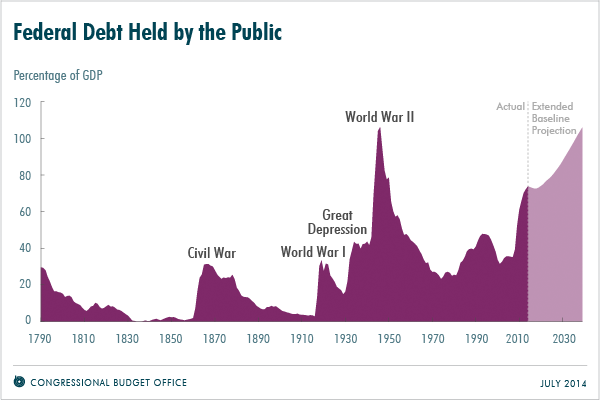Last week CBO released its latest report on the long-term budget outlook. (For a quick overview of the report, take a look at The 2014 Long-Term Budget Outlook in 26 Slides.) Previous blog posts have highlighted the projected imbalance in federal spending and revenues over the next 25 years. Today’s post explains how projected shortfalls would accumulate over time if current laws remained generally unchanged, causing federal debt to grow faster than the economy, and discusses the consequences of such large and growing federal debt. A blog post tomorrow will discuss the magnitude of policy changes that would be needed to meet various possible goals for federal debt.
What Are CBO’s Projections of Federal Debt Over the Long Term?
Debt held by the public represents the amount that the federal government has borrowed in financial markets (by issuing Treasury securities) to pay for its operations and activities. If a given combination of federal spending and revenues is to be sustainable over time, debt held by the public eventually must grow no faster than the economy does. If debt continued to rise relative to gross domestic product (GDP), at some point investors would begin to doubt the government’s willingness or ability to repay its obligations. Such doubts would make it more expensive for the government to borrow money, thus necessitating cuts in spending, increases in taxes, or some combination of those two approaches. For that reason, the amount of federal debt held by the public relative to the nation’s annual economic output is an important barometer of the government’s financial position.
At the end of 2008, federal debt held by the public stood at 39 percent of GDP, which was close to its average of the preceding several decades. Since then, large deficits have caused debt held by the public to grow sharply—to a projected 74 percent of GDP by the end of fiscal year 2014. Debt has exceeded 70 percent of GDP during only one other period in U.S. history: from 1944 through 1950, when it spiked because of a surge in federal spending during World War II to a peak of 106 percent of GDP (see the figure below).

CBO projects that, under current law, federal debt held by the public would exceed its current percentage of GDP after 2020 and continue rising. By 2039, that debt would reach 106 percent of GDP, by CBO’s estimate, without accounting for the harmful economic effects of the growing debt. CBO’s projection accounting for those effects shows debt reaching 111 percent of GDP in 2039. That percentage is greater than what the United States experienced at the end of 1946 and more than two and a half times the average percentage during the past several decades—and it would be on an upward path. That trajectory ultimately would be unsustainable.
What Consequences Would a Large and Growing Federal Debt Have?
How long the nation could sustain such growth in federal debt is impossible to predict with any confidence. At some point, investors would begin to doubt the government’s willingness or ability to pay its debt obligations, which would require the government to pay much higher interest costs to borrow money. Such a fiscal crisis would present policymakers with extremely difficult choices and would probably have a substantial negative impact on the country.
Even before that point was reached, the high and rising amount of federal debt that CBO projects under the extended baseline would have significant negative consequences for both the economy and the federal budget:
- The large amount of federal borrowing would draw money away from private investment in productive capital in the long term, because the portion of people’s savings used to buy government securities would not be available to finance private investment. The result would be a smaller stock of capital and lower output and income than would otherwise be the case, all else being equal. (Despite those reductions, the continued growth of productivity would make output and income per person, adjusted for inflation, higher in the future than they are now.)
- Federal spending on interest payments would rise, thus requiring higher taxes, lower spending for benefits and services, or both to achieve any chosen targets for budget deficits and debt.
- The large amount of debt would restrict policymakers’ ability to use tax and spending policies to respond to unexpected challenges, such as economic downturns or financial crises. As a result, those challenges would tend to have larger negative effects on the economy and on people’s well-being than they would otherwise. The large amount of debt could also compromise national security by constraining defense spending in times of international crisis or by limiting the country’s ability to prepare for such a crisis.
Julie Topoleski is an analyst in CBO’s Health, Retirement, and Long-Term Analysis Division.

